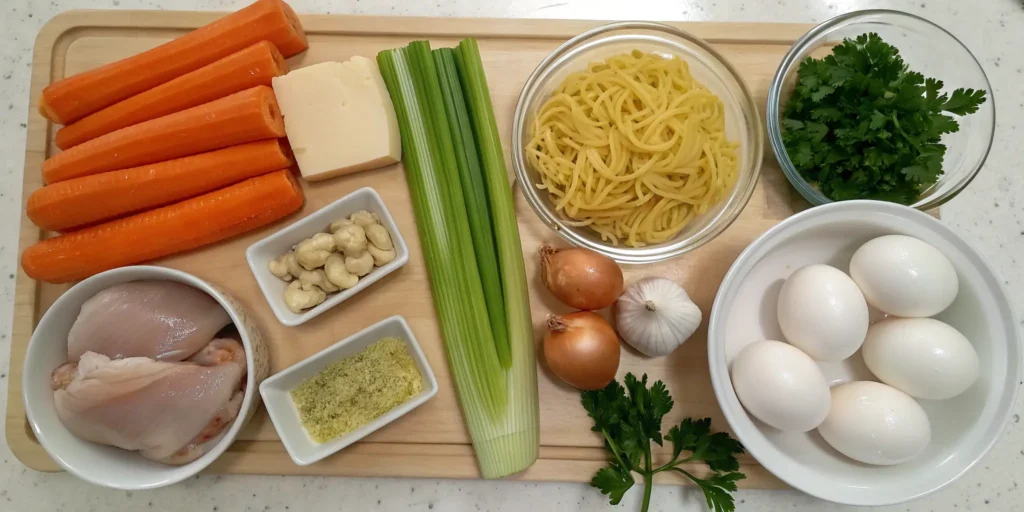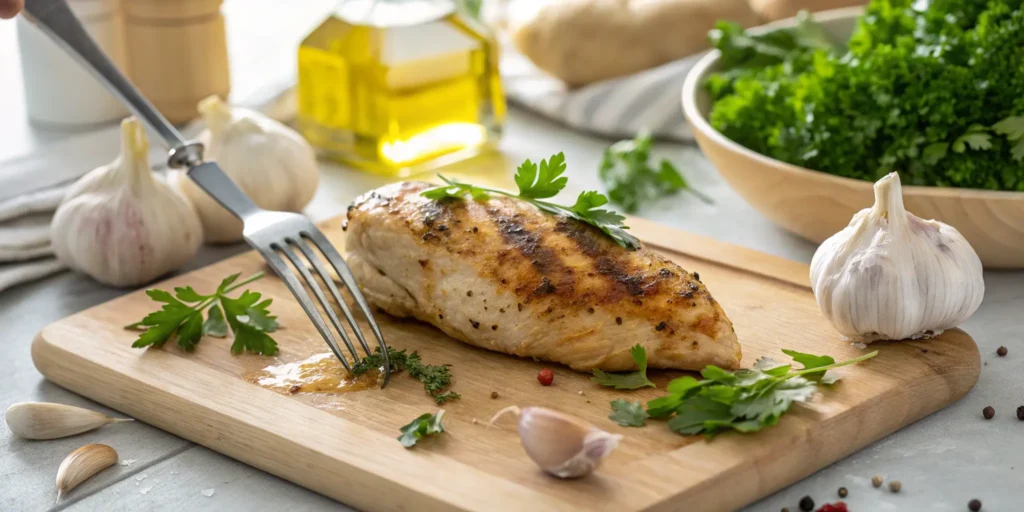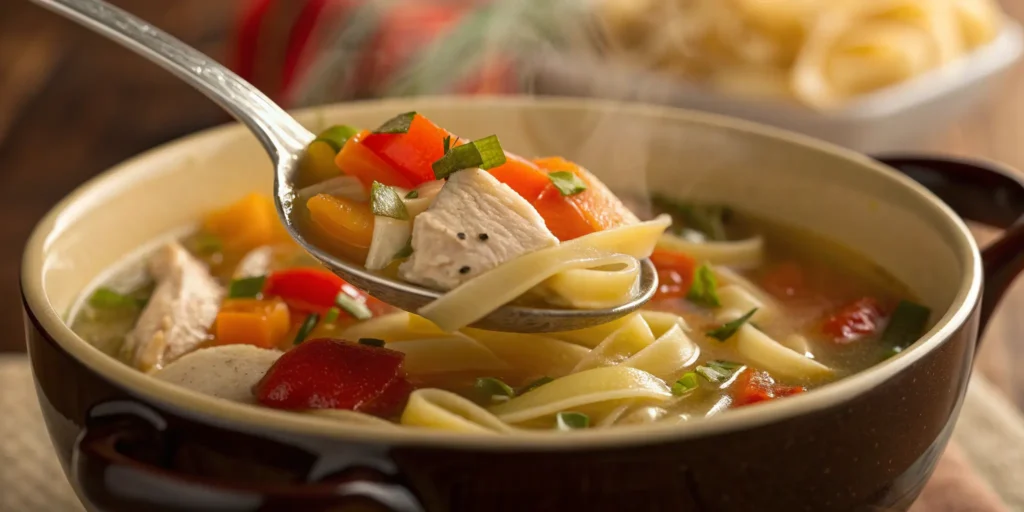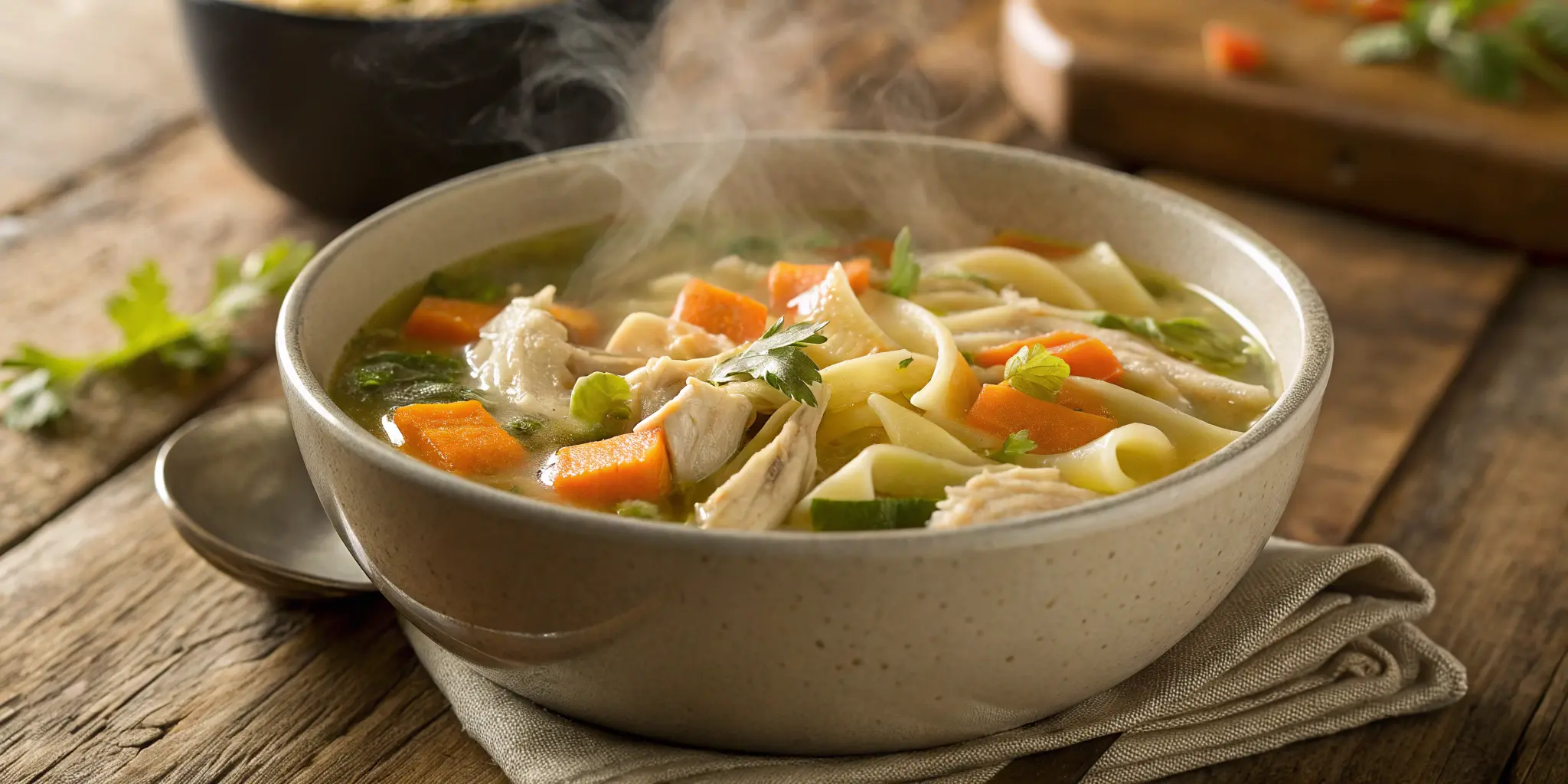Chicken Noodle Soup Recipe: 5 Delicious Easy Flavor Hacks
Table of Contents
Introduction
When life feels heavy or your body needs a little comfort, nothing compares to a steaming bowl of chicken noodle soup. It’s more than just food—it’s a hug in a bowl, the kind of meal that instantly brings back memories of being cared for on a sick day or gathering around the table on a chilly evening. You’ve probably made chicken noodle soup before, but the real question is: how do you transform a simple pot of soup into something unforgettable?
That’s where this guide comes in. Here, you’ll discover how to take a classic chicken noodle soup recipe and infuse it with flavor hacks that elevate it from ordinary to extraordinary. With just a few tweaks, you’ll unlock layers of richness, aroma, and satisfaction that will make your soup taste like it simmered in a professional kitchen.
This isn’t about complicated steps or fancy ingredients. It’s about small, smart changes you can make at home—things like roasting chicken before adding it to the pot, slipping in fresh herbs, or boosting umami flavors in the broth. By the time you finish reading, you’ll have a set of techniques you can use anytime you crave a comforting bowl of chicken noodle soup.
So grab your pot, sharpen your knife, and get ready to learn how to make your chicken noodle soup recipe a dish your family will beg for again and again.
Why Chicken Noodle Soup Recipe Is the Ultimate Comfort Food
Think about the times you’ve reached for chicken noodle soup. Maybe it was when you had a cold and couldn’t taste much else. Maybe it was on a snowy day when you wanted something to warm your body from the inside out. Or maybe it was during a hectic week when you needed a simple, nourishing meal. In every scenario, the soup delivered comfort—and that’s what makes it timeless.
Nourishment That Heals
Chicken noodle soup isn’t just soothing because it’s warm. It actually provides nutrients that support your body:
- Chicken gives you protein that fuels muscle repair.
- Carrots, celery, and onions add antioxidants and vitamins.
- Broth hydrates and replenishes electrolytes, especially important when you’re under the weather.
Familiarity That Calms
You may not realize it, but food memories play a role here too. When you smell simmering chicken and vegetables, you’re instantly transported back to the moments when someone cared enough to make this for you. That emotional tie is part of the reason chicken noodle soup has such staying power.
Flexibility for Every Cook
Another reason this soup recipe never goes out of style is how adaptable it is. You can make it from scratch with homemade stock, or you can throw it together on a busy night using store-bought broth. Either way, it turns out satisfying. That flexibility is exactly why people across generations continue to love it.
When you put all of this together, it’s easy to see why a chicken noodle soup recipe holds such a special place. But once you learn the flavor hacks ahead, you’ll realize that comfort food can also be gourmet.
Classic Chicken Noodle Soup Recipe (Base Version)
Before you dive into flavor hacks, you need a solid base recipe. This is the version you’ll come back to time and time again—the comforting pot of soup that’s warm, hearty, and balanced. Once you master this, you’ll have the freedom to add layers of flavor whenever you want.
Ingredients
Here’s a simple ingredient breakdown for your base chicken noodle soup recipe:

| Ingredient | Quantity | Notes |
|---|---|---|
| Chicken breast/thighs | 1 lb | Thighs add more flavor, breasts stay lean |
| Egg noodles | 8 oz | Wide noodles hold broth well |
| Carrots | 2 medium | Thinly sliced for quicker cooking |
| Celery stalks | 2 | Diced for texture |
| Onion | 1 medium | Chopped finely |
| Garlic | 3 cloves | Minced for depth of flavor |
| Chicken broth | 8 cups | Low-sodium preferred so you can control salt |
| Olive oil | 2 tbsp | For sautéing vegetables |
| Salt & pepper | To taste | Always adjust at the end |
| Fresh parsley | 2 tbsp | Chopped, for freshness |
Pro tip: If you want a richer broth right from the start, replace half the broth with homemade stock.
Step-by-Step Instructions
Follow these steps to build your base soup:
- Prep the vegetables – Chop your onion, slice the carrots, dice the celery, and mince the garlic.
- Sauté the aromatics – In a large pot, heat olive oil over medium heat. Add onion, garlic, carrots, and celery. Cook until softened and fragrant.
- Cook the chicken – Add the chicken pieces directly into the pot and brown them lightly. This step builds flavor.
- Add broth – Pour in the chicken broth and bring everything to a gentle simmer.
- Simmer & shred – Let the soup simmer until the chicken is fully cooked (about 20–25 minutes). Remove the chicken, shred it with two forks, and return it to the pot.
- Add noodles – Stir in the egg noodles and cook until they’re al dente. Don’t overcook; they’ll soften more in the hot broth.
- Season & finish – Taste the soup, adjust with salt and pepper, and finish with fresh parsley.

This is the backbone of your chicken noodle soup recipe—simple, wholesome, and satisfying on its own. But once you’re comfortable with this version, it’s time to unlock the hacks that bring out deeper, bolder flavors.
5 Easy Flavor Hacks to Elevate Your Chicken Noodle Soup Recipe
Once you’ve mastered the base version, the real fun begins. You don’t need a chef’s training to make your chicken noodle soup taste like it came from a high-end kitchen. With a few clever tricks, you can unlock deeper layers of flavor, richer aromas, and textures that keep people coming back for seconds.
Here are five hacks you can start using right away:
Hack #1 – Roast the Chicken for Depth of Flavor
If you’ve ever wondered why restaurant soups taste richer, it’s often because of roasted chicken. Instead of simmering raw chicken in broth, roast it first.
- Why it works: Roasting caramelizes the meat, creating a deeper, smoky flavor that transfers directly into your soup.
- How to do it: Lightly season your chicken with olive oil, salt, and pepper, then roast at 400°F until golden. Shred and add to your broth.
Result: Your chicken noodle soup recipe instantly has layers of complexity without extra steps at the stove.
Hack #2 – Use Fresh Herbs and Aromatics
Dry seasonings can only take you so far. Fresh herbs bring your soup alive.
- Best herbs to try: Thyme, rosemary, and parsley. For a subtle twist, add dill for brightness.
- Aromatics worth adding: Ginger and lemon zest create a refreshing, soothing finish—especially helpful if you’re fighting off a cold.
- When to add them: Add woody herbs like rosemary early in the cooking process; add delicate herbs like parsley at the end.
Result: A chicken noodle soup recipe that smells as good as it tastes.
Hack #3 – Enhance the Broth with Umami Boosters
A flat broth makes the whole soup forgettable. The secret? Umami.
- What to add: A splash of soy sauce, fish sauce, or even a teaspoon of miso paste.
- Balance is key: Start with a small amount and taste as you go. These ingredients pack a punch.
- Other boosters: Mushrooms or a Parmesan rind simmered in the pot also work wonders.
Result: Your chicken noodle soup gets that savory depth that makes people wonder what your secret is.

Hack #4 – Upgrade the Noodles
You might not think noodles matter much, but they can make or break your soup.
- Options to try:
- Homemade egg noodles for a rustic touch
- Rice noodles for a lighter, gluten-free option
- Dumplings for a hearty, Southern twist
- Pro tip: Cook noodles separately if you plan to store leftovers. This keeps them from getting soggy.
Result: Your chicken noodle soup recipe feels customizable and exciting every time you make it.
Hack #5 – Add Creamy or Spicy Twists
Sometimes, a little indulgence or heat takes the soup from comforting to unforgettable.
- Creamy option: Stir in a splash of heavy cream, half-and-half, or even coconut milk for a velvety texture.
- Spicy option: Add crushed red pepper, chili oil, or a spoonful of sriracha for warmth and kick.
- Balanced approach: Pair creaminess with spice—for example, coconut milk with chili flakes—for a bold, modern twist.
Result: Your chicken noodle soup recipe can shift from cozy comfort food to a bold, flavorful bowl with just one small adjustment.
Expert Tips for Perfect Chicken Noodle Soup Every Time
Even with the best hacks in your pocket, there are small details that make the difference between a good chicken noodle soup recipe and one that leaves everyone asking for seconds. If you want consistency every time you cook, here are expert-level tips you can use:
Choose the Right Cut of Chicken
- Dark meat (thighs/legs): Offers a richer, more flavorful broth.
- White meat (breasts): Keeps things lean and light.
- Best of both worlds: Use a mix of light and dark meat for balance.
Control Your Noodle Texture
Nothing ruins a chicken noodle soup recipe faster than mushy noodles.
- Cook noodles separately if you plan to store leftovers.
- Add noodles just before serving when cooking fresh.
- For extra texture, slightly undercook them in the pot—they’ll soften as they sit.
Build Flavor in Layers
Don’t just throw everything in the pot and hope for the best. Take your time to layer flavors:
- Sauté aromatics like garlic and onion before adding broth.
- Deglaze the pot with a splash of broth or white wine after browning chicken.
- Add herbs at different stages for complexity.
Don’t Skimp on Acid
A squeeze of lemon juice or a splash of apple cider vinegar at the end brightens up the broth and cuts through richness. That one small step makes your soup taste fresher.
Make Extra Broth
You’ll often find the broth evaporates or soaks into noodles. Always keep a little extra stock on hand so you can adjust the consistency before serving. Homemade stock freezes well, so you’ll always be ready.
Taste, Adjust, Taste Again
Soups evolve as they simmer. Before serving, taste for salt, pepper, and balance. Sometimes a pinch of salt or a dash of acid is all it takes to make your chicken noodle soup recipe shine.
By following these expert tips, you’ll find that even without extra hacks, your chicken noodle soup can taste vibrant and perfectly balanced. Think of these as your “safety net” for making soup that impresses every single time.
Common Mistakes to Avoid in Chicken Noodle Soup Recipes
Even with the best intentions, it’s easy to make small mistakes that keep your chicken noodle soup recipe from reaching its full potential. By knowing what to watch out for, you’ll save yourself from bland broth, mushy noodles, or dry chicken. Here are the biggest errors you should avoid:
Adding Too Much Salt Too Early
When you season heavily at the beginning, the soup reduces as it simmers and ends up overly salty.
- Fix: Season lightly at first and adjust at the end. Always taste before serving.
Overcooking the Chicken
Chicken can dry out quickly if it simmers too long.
- Fix: Cook until just tender, remove, shred, and return to the pot.
Dropping in the Noodles Too Soon
If noodles sit in hot broth too long, they swell and become mushy.
- Fix: Add noodles toward the end of cooking or boil separately if you’re making a big batch to store.
Skipping the Aromatics
Without onion, garlic, and celery, the soup loses depth.
- Fix: Always sauté aromatics before adding broth. This step builds the foundation of flavor.
Forgetting Fresh Herbs
Dry seasonings alone can leave your soup tasting flat.
- Fix: Finish with parsley, dill, or thyme for freshness and balance.
Letting the Broth Go Flat
A bland broth can make the whole chicken noodle soup recipe forgettable.
- Fix: Add umami boosters like soy sauce, mushrooms, or a Parmesan rind to enrich flavor.
Common Mistakes Quick Fix Table
| Mistake | Result | Quick Fix |
|---|---|---|
| Too much salt too early | Overly salty | Season lightly first, adjust at the end |
| Overcooked chicken | Dry texture | Cook until tender, shred, then return to pot |
| Noodles added too soon | Mushy noodles | Add at the end or cook separately |
| Skipping aromatics | Flat flavor | Sauté onion, garlic, celery before broth |
| No fresh herbs | Lacks freshness | Add parsley, dill, or thyme before serving |
| Weak broth | Bland taste | Add umami (soy, miso, Parmesan, mushrooms) |
By steering clear of these mistakes, you’ll consistently end up with a soup that’s hearty, flavorful, and satisfying. Remember: the small details make all the difference.
FAQs about Chicken Noodle Soup Recipe
What is the secret ingredient in the best chicken noodle soup recipe?
The secret often comes down to building depth in the broth. You can add a splash of soy sauce, a spoonful of miso paste, or even simmer the soup with a Parmesan rind. These small additions bring out a savory richness that makes the soup taste like it’s been simmering all day.
Can I freeze chicken noodle soup?
Yes, you can freeze it, but there’s a trick. If you plan on storing the soup, leave the noodles out before freezing. They soak up liquid and turn mushy over time. Instead, freeze the broth and chicken-vegetable mixture, then add freshly cooked noodles when you reheat.
How do I make chicken noodle soup taste richer?
If your chicken noodle soup recipe tastes flat, try roasting the chicken before adding it to the pot, simmering longer for a concentrated broth, and finishing with fresh herbs. Don’t underestimate a squeeze of lemon juice at the end—it brightens all the flavors.
Can I make chicken noodle soup in a slow cooker?
Absolutely. Cook on low for 6–8 hours or high for 3–4 hours. Add the noodles toward the end or cook them separately. This method gives you tender chicken and a flavorful broth with minimal effort.
What noodles are best for chicken noodle soup?
Wide egg noodles are the traditional choice because they soak up broth while staying chewy. But you can switch it up with rice noodles for a lighter feel, whole wheat pasta for extra fiber, or even homemade noodles for a rustic touch.
Can I make chicken noodle soup without broth?
Yes—you can simmer chicken, vegetables, and herbs in water to create a quick broth as you cook. While store-bought broth saves time, making your own as part of the recipe gives you fresher flavor and more control over the salt content.
Is chicken noodle soup actually good for colds?
While it’s not a cure, studies suggest chicken noodle soup can reduce inflammation in your airways, keep you hydrated, and provide electrolytes. Plus, the warmth and steam help soothe congestion and sore throats, making it one of the best comfort meals when you’re sick.FAQs about Chicken Noodle Soup Recipe
What is the secret ingredient in the best chicken noodle soup recipe?
The secret often comes down to building depth in the broth. You can add a splash of soy sauce, a spoonful of miso paste, or even simmer the soup with a Parmesan rind. These small additions bring out a savory richness that makes the soup taste like it’s been simmering all day.
Can I freeze chicken noodle soup?
Yes, you can freeze it, but there’s a trick. If you plan on storing the soup, leave the noodles out before freezing. They soak up liquid and turn mushy over time. Instead, freeze the broth and chicken-vegetable mixture, then add freshly cooked noodles when you reheat.
How do I make chicken noodle soup taste richer?
If your chicken noodle soup recipe tastes flat, try roasting the chicken before adding it to the pot, simmering longer for a concentrated broth, and finishing with fresh herbs. Don’t underestimate a squeeze of lemon juice at the end—it brightens all the flavors.
Can I make chicken noodle soup in a slow cooker?
Absolutely. Cook on low for 6–8 hours or high for 3–4 hours. Add the noodles toward the end or cook them separately. This method gives you tender chicken and a flavorful broth with minimal effort.
What noodles are best for chicken noodle soup?
Wide egg noodles are the traditional choice because they soak up broth while staying chewy. But you can switch it up with rice noodles for a lighter feel, whole wheat pasta for extra fiber, or even homemade noodles for a rustic touch.
Can I make chicken noodle soup without broth?
Yes—you can simmer chicken, vegetables, and herbs in water to create a quick broth as you cook. While store-bought broth saves time, making your own as part of the recipe gives you fresher flavor and more control over the salt content.
Is chicken noodle soup actually good for colds?
While it’s not a cure, studies suggest chicken noodle soup can reduce inflammation in your airways, keep you hydrated, and provide electrolytes. Plus, the warmth and steam help soothe congestion and sore throats, making it one of the best comfort meals when you’re sick.
Conclusion
At its core, a chicken noodle soup recipe is about more than just broth, noodles, and chicken—it’s about comfort, connection, and nourishment. Whether you’re making it for yourself on a cold evening, preparing a big pot for your family, or bringing it to a friend who needs a little care, this dish carries warmth in every spoonful.
You’ve seen how the classic version lays the foundation, and you’ve learned five easy hacks that can completely transform the flavor. From roasting your chicken to slipping in fresh herbs, boosting broth with umami, upgrading your noodles, or experimenting with creamy and spicy twists, you now have the tools to make every bowl unique and unforgettable.
The best part? You don’t need fancy techniques or endless time in the kitchen. Just a few thoughtful tweaks can turn your soup into a restaurant-worthy meal—one that feels both nostalgic and exciting at the same time.
So the next time you crave comfort, don’t settle for average. Use these tips, avoid the common mistakes, and trust your instincts as you taste and adjust. Every pot you make brings you closer to mastering the chicken noodle soup recipe that’s perfect for your table.
Now it’s your turn—grab a pot, gather your ingredients, and try one of these flavor hacks tonight. Which twist will you start with first—roasting the chicken, adding fresh herbs, or giving your broth that umami punch?
Share your favorite version of chicken noodle soup with friends, experiment with new ingredients, and make this timeless recipe your own. The only limit is your creativity.
Because in the end, your chicken noodle soup recipe isn’t just food—it’s comfort, tradition, and a story you get to tell one bowl at a time.

